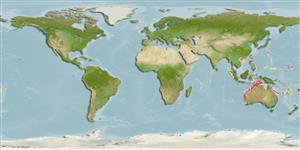Teleostei (teleosts) >
Perciformes/Uranoscopoidei (Sand dwellers) >
Pinguipedidae (Sandperches)
Etymology: Parapercis: Greek, para = the side of + Greek, perke = perch (Ref. 45335); hoi: Named for Dr. Hsuan-Ching Ho.
Eponymy: Dr Hsuan-Ching Ho (d: 1978) is a Taiwanese ichthyologist who is Associate Professor at the Institute of Marine Biology at the National Dong Hwa University, Taiwan (2014–present). [...] (Ref. 128868), visit book page.
Environment: milieu / climate zone / depth range / distribution range
Ecology
Marine; reef-associated; depth range 73 - 109 m (Ref. 116166). Subtropical
Distribution
Countries | FAO areas | Ecosystems | Occurrences | Point map | Introductions | Faunafri
Indo-West Pacific: Western Australia and the
Philippines.
Size / Weight / Age
Maturity: Lm ? range ? - ? cm
Max length : 6.1 cm SL male/unsexed; (Ref. 116166)
Life cycle and mating behavior
Maturity | Reproduction | Spawning | Eggs | Fecundity | Larvae
Johnson, J.W. and H. Motomura, 2017. Five new species of Parapercis (Perciformes: Pinguipedidae) from southeast Asia and northwest Australia. Zootaxa 4320:121-145. (Ref. 116166)
IUCN Red List Status (Ref. 130435: Version 2024-2)
Threat to humans
Harmless
Human uses
Tools
Special reports
Download XML
Internet sources
Estimates based on models
Phylogenetic diversity index (Ref.
82804): PD
50 = 0.5000 [Uniqueness, from 0.5 = low to 2.0 = high].
Bayesian length-weight: a=0.01000 (0.00244 - 0.04107), b=3.04 (2.81 - 3.27), in cm total length, based on all LWR estimates for this body shape (Ref.
93245).
Trophic level (Ref.
69278): 3.3 ±0.4 se; based on size and trophs of closest relatives
Resilience (Ref.
120179): High, minimum population doubling time less than 15 months (Preliminary K or Fecundity.).
Fishing Vulnerability (Ref.
59153): Low vulnerability (10 of 100).
